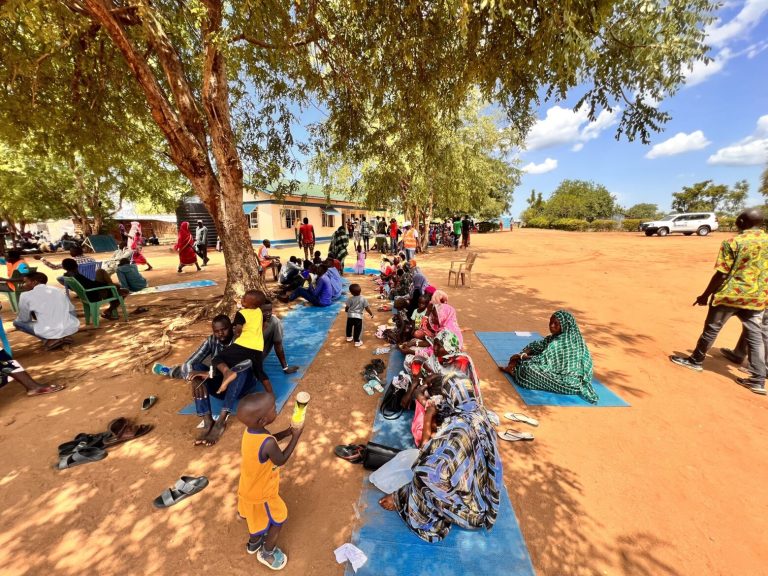Rethinking Aid Worker Safety in South Sudan: A Call for Equitable Protection
Recently arrived Sudanese refugees wait to be registered at Gorom refugee camp near Juba, South Sudan. Photo Credit: Refugees International
South Sudan has long been one of the world’s most dangerous places for humanitarian workers, but the risks faced by local aid staff have been largely overlooked. As we grapple with an increasingly complex global landscape of humanitarian crises, it’s time to confront the stark inequalities and systemic issues that put South Sudanese aid workers at disproportionate risk.
The statistics are alarming: 94% of aid workers killed in South Sudan between 2011 and 2023 were South Sudanese. This reflects a global trend where national staff face per capita fatality rates more than three times higher than their international counterparts. Yet, these deaths often go unnoticed by international media, which tends to focus on the rare instances when expatriate staff are harmed.
The reasons behind this disparity are multifaceted and deeply rooted in the socio-economic realities of South Sudan. Local aid workers, often among the most educated and well-paid members of their communities, become targets in a context where humanitarian assistance has become a major economic force. They face unique risks, including “revenge killings” and being caught in the crossfire of violent struggles over access to vital relief supplies.
Paradoxically, the very qualities that make local staff invaluable to aid operations – their community connections and local knowledge – also expose them to greater danger. Unlike their international colleagues, they can’t simply take off their vest and retreat to a guarded compound at the end of the day. Their role as providers for extended family networks makes them high-value targets in a society grappling with widespread food insecurity and economic instability.
The humanitarian sector’s push for localization, while well-intentioned, has inadvertently exacerbated these risks. As more responsibilities shift to local NGOs, there hasn’t been a corresponding transfer of resources for security management. This “dark side of localization” leaves national organizations ill-equipped to protect their staff in high-risk environments.
Moreover, the hiring practices of international aid organizations sometimes contribute to local tensions. The preference for English-speaking staff from the capital over locals in project areas has led to protests and violence against non-local South Sudanese aid workers, highlighting the complex dynamics at play.
To address these challenges, we need a fundamental shift in how the humanitarian sector approaches security and risk management in places like South Sudan. This includes:
- Recognizing and addressing the unique risks faced by national staff, both on and off duty.
- Providing equitable security resources and training to local NGOs.
- Placing more South Sudanese aid workers in leadership positions, including security roles, to better understand and navigate local conflict dynamics.
- Implementing more nuanced and context-sensitive hiring practices that balance local employment with conflict sensitivity.
- Empowering staff to refuse dangerous assignments without fear of losing their jobs.
As humanitarian crises continue to proliferate globally, the protection of national aid workers must become a priority. Their safety is not just a moral imperative but a practical necessity for effective humanitarian response. It’s time for the international community to confront this issue head-on, acknowledging the true cost of aid work and working towards a more equitable and secure environment for all humanitarian staff, regardless of their nationality.
-

Ethiopia Names New Ambassador to Somalia as Diplomatic Relations Warm
Edited By : Widad WAHBIIn a further sign of improving diplomatic relations between Ethiopia and Somalia, Ethiopian diplomat Suleiman Dedefo... Regional and international cooperation -

Nigeria Issues Urgent Flood Alert for 19 States as Heavy Rains Loom
Edited By : Tendai Zola Nigeria’s Federal Ministry of Environment has issued a critical flood alert for 19 states amid forecasts... Environment -

Four Moroccan Truck Drivers Freed from ISIS-Affiliated Captors in Sahel Region
Edited By: Africa Eye ( With Press Agencies) The government of Mali has announced the safe release of four Moroccan truck... Fight against extremism and terrorism -

Tinubu urges youth to lead Nigeria’s digital transformation
Edited by: Fatima BabadinThe digital era stands at the heart of Nigeria’s aspirations for growth, as President Bola Ahmed Tinubu... West Africa - Sahel -

West Africa: A Legislative Bridge Rises Across the Mano River
Edited by: Fatima BabadinIn a bold stride toward regional integration, Sierra Leone, Liberia, Côte d’Ivoire, and Guinea have formally launched... West Africa - Sahel -

Tragedy in Zamfara: 35 Hostages Killed Despite Ransom Payment
Edited By: Tendai Zola In a horrifying escalation of violence in northwest Nigeria, armed kidnappers have executed 35 villagers in Banga,... Security trends

 Follow the latest news on WhatsApp
Follow the latest news on WhatsApp  Follow the latest news on Telegram
Follow the latest news on Telegram  Follow the latest news on Google News
Follow the latest news on Google News  Follow the latest news on Nabd
Follow the latest news on Nabd 

















